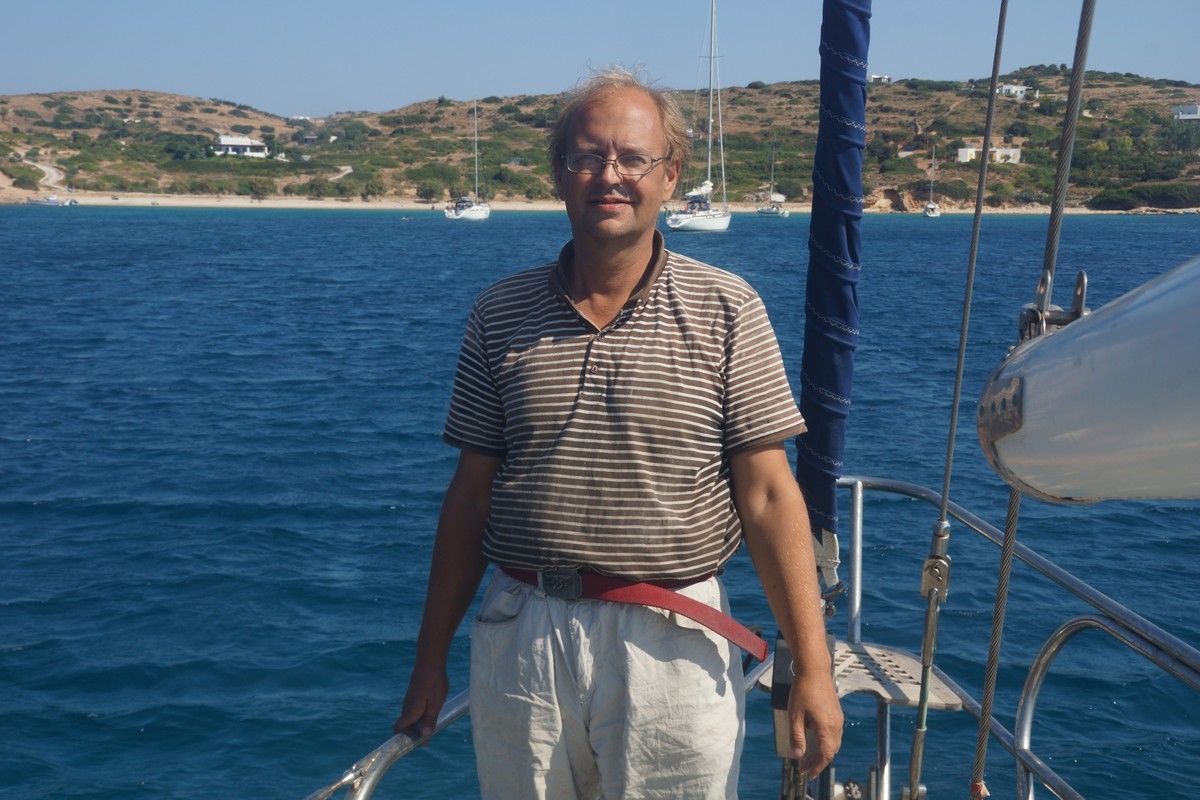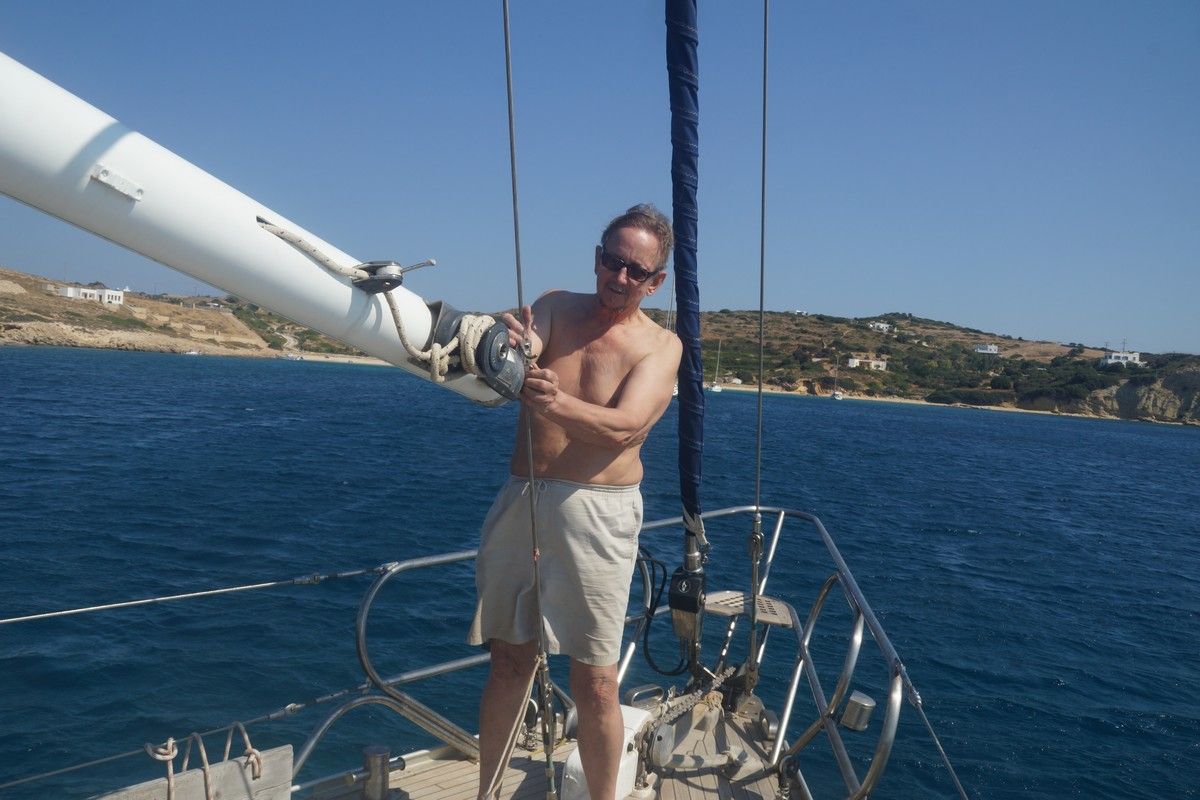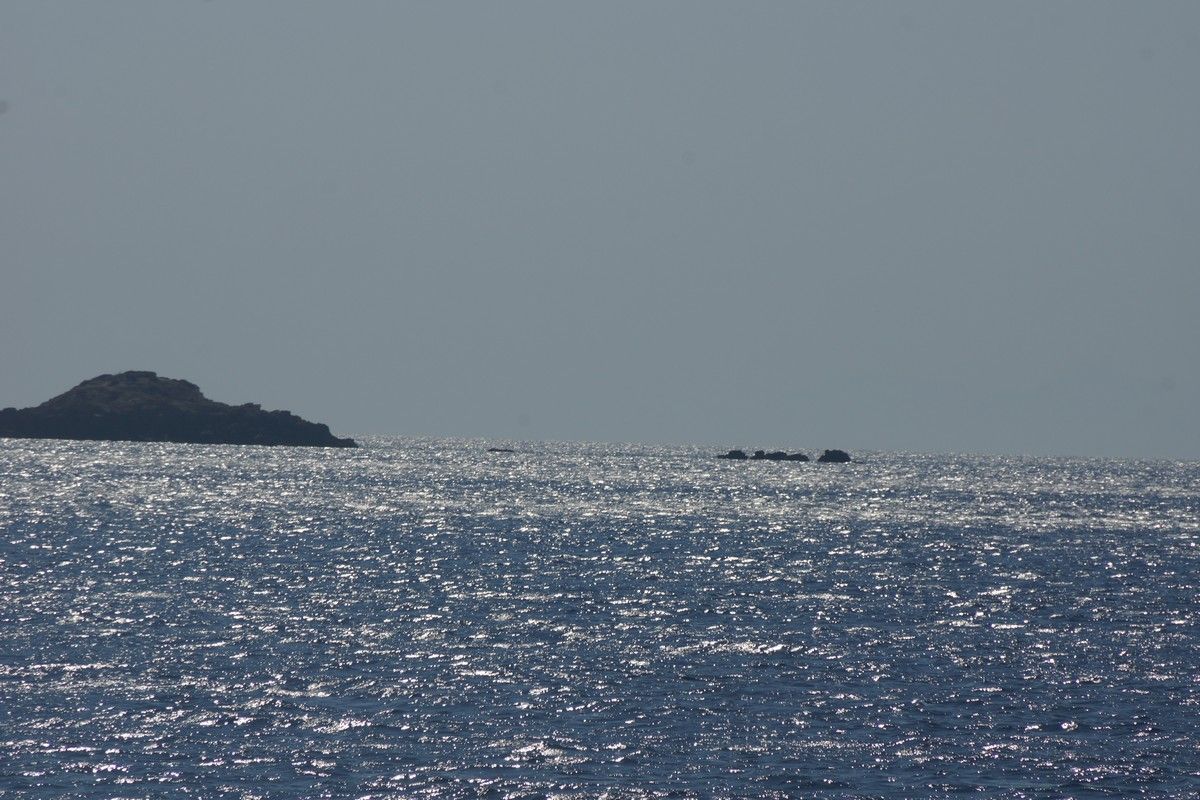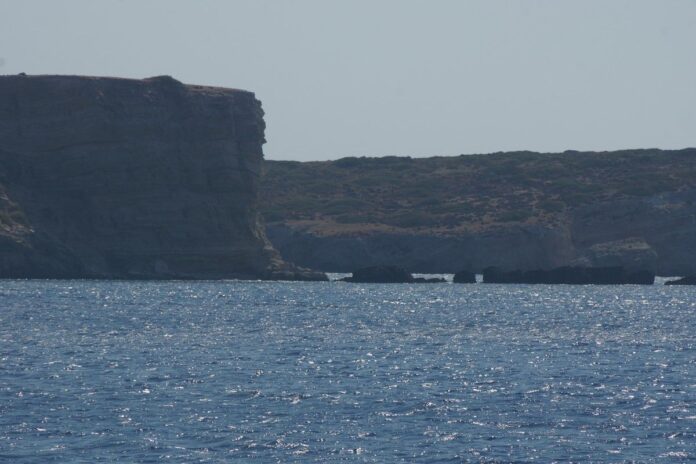The second day turned out to be the most challenging. It would seem that we covered even less distance than on the first day. But an unexpected problem arose — finding a good anchorage. However, this is actually wonderful. In a yacht tour around the Greek islands, there is always room for something new and unexpected.
Nothing foreshadowed any adventures. We left the island of Lipsi in a routine manner. The wind was strictly astern along the way. And it is only amateurs and those dreaming of sailing journeys who wish us a tailwind. In reality, this is actually one of the most inconvenient options.
The thing is, there are too few of us, just two, to properly deploy the gennaker. One at the helm, and the other struggling with the large parachute sail is difficult. This means we have to adapt to the tailwind with what we have, trying to set the genoa in a “butterfly” formation—one side forward and the mainsail on the opposite side.
A potential issue is that the wind is unstable. Therefore, we have to ensure that it doesn’t suddenly shift the mainsail from one side to the other due to slight course or wind direction changes. This is both unpleasant and potentially dangerous, if the boom were low. Fortunately, ours is high, but sudden movements are still harmful to the mast.

As always in such cases, following the lessons of English yachting, I used a “preventer”—a rope that prevents the uncontrolled movement of the boom. This is done by tying one end to the boom, running it through something sturdy on deck, and securing it back in the cockpit on a free winch or another strong point. This way, the boom is fixed on one side but can be released into free movement at any moment if necessary.
All in all, sailing is faster and more reliable when the wind is slightly off-center rather than directly from behind—this is known as “sailing in a goosewing formation.”

Searching for an Anchorage
Of course, we knew in advance where we were headed. There is a small island directly on our course toward Kos. It is called Pitta, and it has a suitable bay on the south side, just as expected for the wind to pull the boat away from shore at anchor. Moreover, the electronic chartplotter marks an anchorage spot at exactly the right location.
But we were driven away. Here’s what happened: we entered the bay, and there was nothing and no one around, just some barracks under a flag on the slope. Apparently, a military border outpost. Which is fine, nothing wrong with that.
We chose a spot. I repeatedly brought the bow of the yacht closer to shore in different areas, looking for the best place to drop anchor. Then, suddenly, soldiers ran out and waved at us—telling us that anchoring here is not allowed. And you can’t argue with them; they have automatic rifles…
Alright, if they don’t want neighbors, we won’t insist. We understand that the border is near. And not just any border, but one with a historically serious and unpredictable neighbor—Turkey.

We had neither the time nor the opportunity to explain that, friends, I am practically Greek myself, and if anything happened, I would fight for this island as if it were my own. Besides, to explain anything, we would have had to shout over a hundred meters. No need to escalate the situation. Demonstratively shrugging our shoulders, we left. And, of course, no photos—so as not to reveal our allies to the enemy.
We moved further away and studied the maps again. The nearest island was Kalymnos, which has a bay that looks absolutely stunning. On the chart, it is marked as Vathi, but I know that Greeks call almost all old ports “Vathi.”
This bay on the eastern side of the island is a narrow passage between cliffs. Depths are marked as follows: 30 meters in the middle, 5 meters closer to the shores. It is quite narrow, but there are other boats anchored. The wind, however, rushes through like a tunnel between two walls, blowing straight toward the entrance.
We entered and tried. I made three honest attempts. You don’t drop anchor at 30 meters. Stretching the anchor chain along the wall is risky—if the wind shifts, it will throw the boat onto the rocks, and fenders won’t help.
I even tried stretching the chain through the passage. It worked, but the boat kept swinging back to the middle, and there are other vessels passing through…
I asked the neighbors how they were anchored. They explained that they tied one end of the stern to the cliff. Interesting—how? There’s nothing to tie onto. Did they hammer in a climbing anchor? No, that’s not for me. I am principled—I never leave any damage or even traces of my presence.
Ultimately, without success, we decided to leave again and look for a better spot. We would have tried more and probably figured something out, but by then, the sun had set behind the mountains, and it was completely dark. In such conditions, properly securing the yacht wouldn’t be possible, and we didn’t want to take risks.
We must return to this bay in daylight. It’s so beautiful, and coming back with a tender to explore would be worth it.
So, we left. And a small problem arose. The port engine wouldn’t start—the battery, after sitting idle, didn’t charge. That means it’s dead and needs replacing.
Technically, on Ganesh, this could be done on the go, right at sea, by swapping it with another battery, such as one of the two for the radio, and then powering the radio from the service battery. A normal boat has only two batteries—one for the engine and one for everything else. We have seven! Always options available.
The issue is, it’s night, and we are tired and ready for dinner. And the nearest replacement battery is 200 amps, weighing 40 kilograms! Not exactly eager to haul it around…
So, we decided to continue on one engine to the next location, charging the dead battery from the generator along the way as much as possible. But when only one engine runs, the boat drifts to one side. That means disabling autopilot and manually compensating with the wheel. This also means keeping speed low, or else it still veers off course.
Said and done. Over two hours of manual steering at night, navigating between islands by instruments. We arrived at the same Kalymnos island but on the southern side, where there is a port.
However, by now, it was 10 PM, pitch dark. No help expected at the dock. The known issue with this port—depths are not sufficient everywhere. And as we approached, we saw no free spots.
In such cases, there are two options: go back to sea and spend the night underway, or find a place to drop anchor nearby. The second is safer and better.
We chose the latter. After much effort, we found a spot at the western entrance, leaving the eastern side as a backup. The depth difference was drastic—10 meters, then suddenly 2! But we didn’t run aground—we were watching carefully.
As expected, by then, the second battery of the left engine had recharged enough to start the engine without issue.
Anchor dropped—finally, the day was over. Time for dinner. The menu: delicious beef with mushrooms, vegetables, and even a bit of local Greek wine.
But is the day really over? The wind is still from the north, which is fine for now, but what about the whole night?
So, the skipper stays on night watch…






